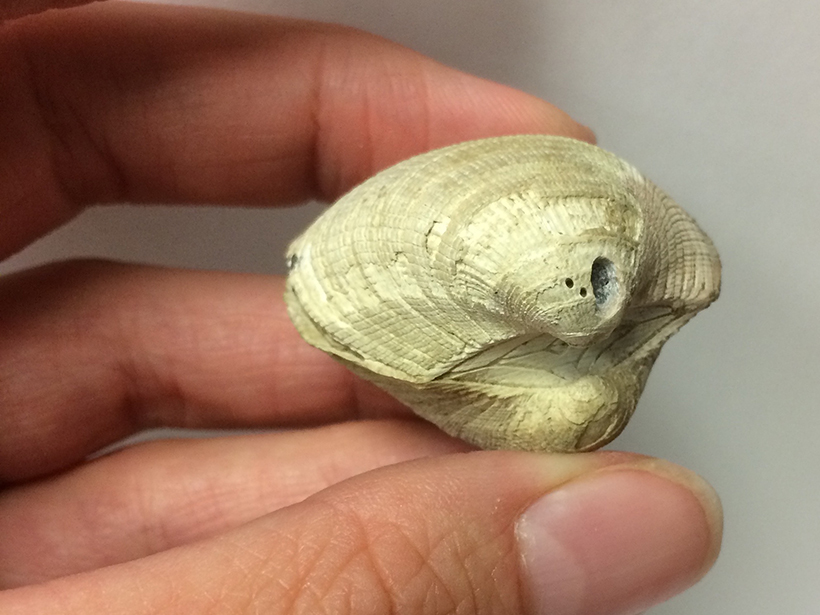Researchers have reported, on the basis of a new reconstruction of Antarctic Ocean temperatures during the period when the dinosaurs died off, that they can discern climate effects caused by two cataclysms—a cluster of volcanic eruptions that lasted for about 750,000 years and a meteorite that struck long after eruptions began. The findings, published in Nature Communications, show that both events at the end of the Cretaceous period correlate with temperature spikes in ocean waters.
“There is always uncertainty when it comes to geological dating, but we can broadly show a strong correlation between the timing of ocean warming events, the two extinction periods, and the onset of volcanism and the meteorite impact,” said lead author Sierra Petersen, a postdoctoral researcher in the Department of Earth and Environmental Sciences at the University of Michigan in Ann Arbor.
Surveying Ancient Seas
Petersen and other scientists have investigated ancient sea temperatures because they can reflect climate change from volcanism or meteorites. “Temperature changes show how volcanoes [in India] could have impacted species in Antarctica from so far away,” said Petersen.
“Temperature changes show how volcanoes [in India] could have impacted species in Antarctica from so far away.”
A prior study published in 2012 found two distinct extinction events by analyzing mollusk fossils from the end of the Cretaceous period found on Seymour Island, which is located off the tip of the Antarctic Peninsula. However, only the first event coincided with ocean warming.
According to the findings, the first extinction event occurred as ocean temperatures spiked from 8°C to 12°C during a series of eruptions at the vast volcanic terrain in India known as the Deccan Traps. At the time, Seymour Island was under water, and oceanic species like clams would have been directly affected by temperature change.
The second extinction occurred about 150,000 to 200,000 years later when a roughly 10-kilometer-wide meteorite hit the Yucatán Peninsula of Mexico, but ocean temperatures appeared to have remained stable during the event, said Tom Tobin, a geologist at the University of Alabama in Tuscaloosa, who led the 2012 study.
The findings raised questions about the popular notion that the dinosaur extinction occurred because of a massive meteorite impact. However, some researchers have harbored doubts about the techniques that Tobin used to date the clam shells. According to Petersen, Tobin’s methods made unverified assumptions about ocean conditions.
Tobin and his team used what’s known as the oxygen isotope paleothermometer technique, which measures ratios of oxygen-16 (16O) and oxygen-18 (18O) in mollusk shells. As this ratio changes with temperature, it reflects the conditions in which shells formed millions of years ago. However, “these methods are uncertain because they require estimates of past ocean conditions,” said Petersen. “We can’t know how much 16O and 18O were in the water to begin with—especially when looking back in time 60 million years, so assumptions have to be made in order to relate isotope variation to temperature.”
Carbon as a Sign of Cold Water
To avoid these pitfalls, Petersen used what’s known as a “clump isotope” technique that measures both 18O and carbon-13 (13C). The probability that heavy oxygen binds to 13C is higher in cooler waters, which allows scientists to relate absolute temperature to the clumping of the two isotopes in the same molecule without making assumptions about past ocean conditions. “The colder the water, the more clumping,” said Petersen.
The analysis of her team’s samples of fossil clams—also from Seymour Island—revealed two periods of ocean warming that occurred during the extinction events. In the first, ocean temperatures spiked by 7.8°C, rising from 3.7°C to 11.5°C, around the same time as the Deccan Traps erupted, the team reported in its 5 July paper.
After this first increase, oceans started to cool and stabilize until the meteorite hit, said Petersen. Shortly after the Chicxulub impactor slammed into the Earth, sea temperatures rose by 1.1°C, from 6.6°C to 7.7°C.
The ecosystems may have already been strained when the meteorite strike drove species over the brink to extinction.
“The first [volcano-related] warming period is pretty significant, and it’s found at the same time we saw our warming event,” said Tobin. “There is definitely something going on.” Yet Tobin remains skeptical about a second warming period following the meteorite impacts. “It is definitely an interesting finding, but we need more research on this interval to confirm,” added Tobin. He noted that the error margin for each temperature sample was almost 1°C, so the cumulative findings of ocean warming of slightly more than a degree could merely reflect ambiguities in the measurement.
Because volcanic activity continued during the meteorite impact, scientists have long debated which upheaval was most instrumental in causing climate change and thus extinction. Petersen suggested that ecosystems may have already been strained by the volcanism’s effects when the meteorite strike drove species over the brink to extinction. She noted that the new findings she and her colleagues have reported are the first to show that ocean warming was correlated with the volcanic activity and meteorite impact and the related extinctions.
Over the past few years, support has mounted for this dual-causation model, called the press-pulse hypothesis, which suggests that a gradual change in volcanic carbon dioxide emissions applied pressure to the environment before a pulse of life-threatening effects from the meteorite crash accelerated extinction. However, to prove this hypothesis, research like the current study would have to be repeated at many locations around the globe, said Tobin.
—Amy Coombs, Editorial Intern
Citation:
Coombs, A. (2016), Climate warming may have helped kill the dinosaurs, Eos, 97, https://doi.org/10.1029/2016EO055845. Published on 14 July 2016.
Text © 2016. The authors. CC BY-NC-ND 3.0
Except where otherwise noted, images are subject to copyright. Any reuse without express permission from the copyright owner is prohibited.

